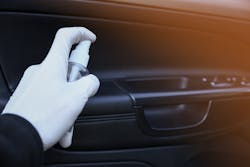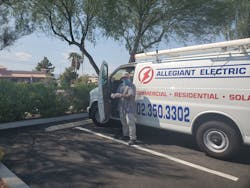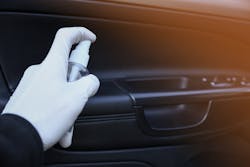As the pandemic bore down, contractors quickly understood their fleets could transport more than workers, materials, and tools. The virus could be hitching a ride, too, endangering employees and potentially spreading far and wide to others as vehicles ranged out to supply houses, routine stops, and customer job sites. Then, with the pandemic’s grip tightening and lockdowns spreading, business for many began receding, leading to changes in vehicle utilization that reverberated with implications for a range of fleet-related budget considerations. For the many contractors whose essential work continued in some fashion, the pandemic changed how many operated, including procedures for getting staff and materials positioned. Unexpectedly, fleets have emerged in this inscrutable year to become a source of fresh headaches for already burdened businesses.
OCD is A-OK
A change touching almost every responsible contractor is the need to minimize the chance that vehicles harbor and possibly transmit the virus. That means doing something brand new to most: enlisting vehicle users (now more routinely gloved and masked) to frequently apply cleaners and disinfectants as thoroughly as practical to vehicle surfaces and contents during the workday, and, in some cases, scheduling deep cleanings. Though modestly time consuming and costly, the practices have for now become daily standard operating procedure for many contractors aware that their mobile businesses can become vector for spreading the virus among employees, other contractors, customers, and the public at large.
Vehicle operators at USIS, Pearl River, N.Y., are now issued bottles of liquid hand sanitizers and disinfectant wipes or spray and instructed to use them liberally and consistently while in the field, says Warehouse and Logistics Manager Trevor Castagna.
“At the beginning and end of each day, they’re supposed to disinfect the cabs with a full wipe down using the wipes, so over a 12-hour period each vehicle is getting a fresh cleaning,” Castagna says.
At Allegiant Electric, LLC, Las Vegas, service technicians are asked to spray and wipe down vehicle interior surfaces as well as tools as frequently as possible — and to wear gloves ahead of contacting surfaces that could be contaminated, such as fuel dispensers, says Owner Andrea Vigil.
Both Allegiant and USIS also set aside time to thoroughly disinfect vehicles when not in service, hoping to root out any contamination that might escape periodic daily surface cleanings. Once a week, USIS cleaning crews hook up $500 fogging machines to disinfectant in 55-gallon drums that cost $1,500 and apply it in mist form to each vehicle. Allegiant brings in an outside company to extensively clean its fleet of eight vehicles while weekly safety meetings are conducted. Both companies say the cleanings provide an extra layer of insurance that vehicles don’t become sources of contamination and visibly demonstrate the company’s concern with keeping employees safe.
“It’s another layer of protection that gives our people a feeling of security,” Castagna says.
Doing it right
The frequency of vehicle cleaning is a top consideration, but equally important is the selection of a cleaning agent and the thoroughness of application. To be effective against the coronavirus, cleaners need to have disinfectant action that comes from a solution that contains no less than around 66% to 70% alcohol, experts say. The safest course when it comes to proper selection is to consult U.S. Environmental Protection Agency or U.S. Centers for Disease Control lists of approved products with demonstrated effectiveness in neutralizing the virus.Participants in a spring webinar on fleet policies to reduce COVID-19 risks, sponsored by Automotive Fleet Magazine, noted that some products marketed early in the pandemic weren’t meeting minimum effectiveness standards. They added that proper application is key ― allowing solution to remain wet on the surface briefly helps ensure efficacy, for example ― and that adhering to an application checklist guards against a slapdash approach. Employees regularly exposed to cleaning agents used in enclosed spaces might need to protect themselves by having adequate ventilation in vehicles and donning some level of personal protective equipment (PPE).
Mike Albert Fleet Solutions, a Cincinnati-based fleet management company, encourages companies to have multi-point checklists for vehicle disinfecting that include every touchable surface. Companies that have drivers sharing vehicles should have procedures to follow and should consider idling a vehicle for 24 to 48 hours between driver changes as an extra precaution. That’s often impractical, so one way around that is to permanently pair up a driver and a vehicle, a tactic USIS has been working to implement.
While virus control demands more frequent and thorough vehicle cleaning, it carries some risk. Heavy use of alcohol-based cleaners and failure to use surface-appropriate ones could lead to damage. Some vehicle suppliers have issued guidelines, but it mostly falls to companies to understand proper application and avoid harming sensitive interiors, which could incur costs and devalue vehicles. Over time, says Joseph Voors, national client partnerships manager for Mike Albert Fleet Solutions, a new generation of more surface-friendly deep-cleaning/disinfecting agents, which might not have to contain alcohol, might emerge.
“Additional research has been conducted to ensure that the intense cleaning products used on vehicle interiors don’t harm the electronics in the vehicles,” he says.
Utilization issues
While inconvenient, new cleaning regimens for contractors probably haven’t proven overly disruptive to fleet operations. However, other byproducts of the pandemic have — at least for some. Among them are changes to vehicle utilization. Early on, as lockdowns spread and business fell off, contractors began wrestling with challenges that included safely manning vehicles, the financial and operational consequences of idling part of their fleets, and complying with new client requirements for safely navigating job sites. In short, predictability became another casualty of the pandemic.
USIS, for example, pulled 30 of its 70 vehicles off the road as projects were put on hold, yielding a period of savings on insurance, fuel, tolls, and overall wear and tear. But that was offset some by costs incurred from idling the vehicles and the logistical challenge of getting most of them road ready again quickly as projects opened back up with minimal notice.
“We experienced some adverse cost effects,” Castagna says. “The extended storage time created some mostly minor mechanical problems. Some braking equipment on older trucks had rusted, battery replacements were needed in some, and we had to reset engine control modules and other electronics in others. But we also took the opportunity to do some things we couldn’t do easily before, like swapping out vehicle GPS systems.”
Other contractors had to scramble to find additional vehicles when customers instituted new rules on vehicle occupancy. Some key utility customers of O’Connell Electric Company, Victor, N.Y., told contractors the new rule was one person per vehicle. That left O’Connell with only one choice.
“We had to rent and utilize very pickup truck we could find when a Maine utility said they didn’t want two people in a cab,” says Vic Salerno, CEO. “That’s what we normally do, so we had to rent a lot of extra vehicles to get workers up there. It was expensive, but they paid for it.”
Allegiant’s vehicle needs have grown since the pandemic struck. After an initial slow period, business has been booming in the Las Vegas area, especially in solar installs, a company specialty, Vigil says. That increase, along with a new focus on limiting vehicle occupancy to one person as much as possible, led to the company expanding its fleet by three vehicles to a total of eight.
“Before this, we’d send out at least two per vehicle, but now it’s one,” says Vigil. “If we need a second person on a job, we’ll send them out in another vehicle.”
Changing logistics
Evolving customer requirements on job-site density and access control have also changed delivery logistics for some contractors, impacting vehicle utilization, positively in some respects. What had been a growing adoption of a just-in-time approach to materials deliveries, often resulting in a pile-up of vehicles and people at job sites, may be giving way to a more structured, scheduled approach. USIS has been seeing that on some of its projects, resulting in fewer and more planned deliveries to sites, more densely packed trucks, larger drop-offs, and less operational flexibility. That has limited the company’s ability to extract full value from its extensive prefabrication operations geared to enabling just-in-time deliveries, but prefab is still helping in the drive to improve job-site efficiency through better timed deliveries and enhance social distancing on them.“More sites are requiring scheduled delivery times, requiring better planning by project managers and foremen and that means less frequent trips into the city (New York metro),” Castagna says. “A line of trucks waiting to get into a site would go around the block before, but that’s almost non-existent now because delivery times are more spaced out. A plus is our drivers don’t have to leave 90 minutes early to get in line, and they’re in and out of the city in a reasonable amount of time.”
But new restrictions by some customers, existing alongside unchanged procedures from others, has translated generally into more challenge for fleet operations, Castagna says.
“Before, out of a group of customers we might have only a couple requiring times, now we may have 10,” he says. “There are some savings on fuel costs and wear and tear on vehicles, but logistical problems trickle down to servicing other sites that are not restricting deliveries.”
These contractor experiences may be illustrative of some of the fleet management considerations that could persist or even grow for contractors. With little certainty of when the pandemic will subside and whether previous business norms will ever return, contractors may be making decisions about fleet size, composition, structure, and overall planning with lower visibility than usual and more guesswork.
Mike Albert Fleet Solutions sees the pandemic experience dictating the need for fleet managers to rethink standard practices and prepare for a future that could look different than the past. Assumptions about utilization that have long guided strategies for efficient operations could be challenged if a “new normal” takes hold for contractors.
Reassessing needs
According to Voors, electrical contractors might be wise to “take a hard look at the size, age, and total cost of their fleet.” If vehicle usage is projected to decline, consideration should be given to “right-sizing” fleets by accelerating disposal of aging, inefficient vehicles and evaluating acquisition options to bring operating expenses in line with revenues. Additionally, existing vehicle leases might be ripe for restructuring if mileage projections have changed.
Another potential landmine for contractors lies in challenges to getting vehicles regularly serviced. Voors says recent company data shows clients have cut back on servicing by 13% on average in the last year, the result of more difficulty in scheduling service appointments. Slips in preventive, routine maintenance can take a costly toll on fleet economics, so the company has begun offering a service focused on helping clients stay on top of fleet service.
Disruptions to predictable fleet operations in the wake of the pandemic have been felt swiftly and broadly for many contractors, but there may be a lingering sense they’re temporary; if the pandemic is brought under control, the thinking goes, it’s back to business as usual. There’s a case to be made, though, that maintaining cleaner vehicles, operating fleets more efficiently, and ensuring they only transport people and materials ― not pathogens ― will demand more sustained attention. Mike Albert Fleet Solutions hints that will be the case, noting that its engineers are studying whether there are changes to vehicle design that can make fleet operations better prepared for an uncertain future.
“Our team is exploring alternative designs that help facilitate deeper and easier cleaning and disinfecting, technologies that enable contactless functions and ways to improve ventilation and filtration, upfits that use designs and materials that are easier to clean, and distancing solutions such as vehicle partitions,” Voors says.
Knowing now how fast a virus can spread, paying much closer attention to such fine-tuning and refining of fleet operations so they don’t play the dreaded role of “super spreader” must be on every fleet manager’s radar.
For more guidelines on limiting the chance of vehicle-borne virus spread, check out the photo gallery on "Fleet Vehicle Cleaning in the Age of COVID-19," which we put together from information recently released from a U.S. General Services Administration document.
Zind is a freelance writer based in Lee's Summit, Mo. He can be reached at [email protected].
About the Author
Tom Zind
Freelance Writer
Zind is a freelance writer based in Lee’s Summit, Mo. He can be reached at [email protected].



